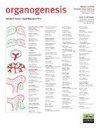Specification of Sprouty2 functions in osteogenesis in in vivo context
IF 2.8
4区 生物学
Q4 BIOCHEMISTRY & MOLECULAR BIOLOGY
引用次数: 2
Abstract
ABSTRACT Sprouty proteins are modulators of the MAPK/ERK pathway. Amongst these, Sprouty2 (SPRY2) has been investigated as a possible factor that takes part in the initial phases of osteogenesis. However, the in vivo context has not yet been investigated and the underlying mechanisms taking place in vitro remain unknown. Therefore, in this study, the impact of Spry2 deficiency was examined in the developing tibias of Spry2 deficient (-/-) mouse. The investigation was performed when the osteogenic zone became clearly visible and when all three basic bone cells types were present. The main markers of osteoblasts, osteocytes and osteoclasts were evaluated by immunohistochemistry and RT-PCR. RT-PCR showed that the expression of Sost was 3.5 times higher in Spry2-/- than in the wild-type bone, which pointed to a still unknown mechanism of action of SPRY2 on the differentiation of osteocytes. The up-regulation of Sost was independent of Hif-1α expression and could not be related to its positive regulator, Runx2, since none of these factors showed an increased expression in the bone of Spry2-/- mice. Regarding the RANK/RANKL/OPG pathway, the Spry2-/- showed an increased expression of Rank, but no significant change in the expression of Rankl and Opg. Thanks to these results, the impact of Spry2 deletion is shown for the first time in the developing bone as a complex organ including, particularly, an effect on osteoblasts (Runx2) and osteocytes (Sost). This might explain the previously reported decrease in bone formation in postnatal Spry2-/- mice.Sprouty2在体内成骨中的功能规范
发芽蛋白是MAPK/ERK通路的调节剂。其中,Sprouty2 (SPRY2)已被研究为参与成骨初始阶段的可能因素。然而,体内环境尚未被研究,体外发生的潜在机制仍然未知。因此,在本研究中,我们研究了Spry2缺失对Spry2缺失(-/-)小鼠胫骨发育的影响。当成骨带清晰可见并且所有三种基本骨细胞类型都存在时进行调查。采用免疫组化和RT-PCR检测成骨细胞、骨细胞和破骨细胞的主要标志物。RT-PCR结果显示,Spry2-/-中Sost的表达量是野生型骨的3.5倍,提示Spry2对骨细胞分化的作用机制尚不清楚。Sost的上调与Hif-1α的表达无关,与其阳性调节因子Runx2无关,因为这些因子在Spry2-/-小鼠骨中的表达均未增加。在RANK/RANKL/OPG通路中,Spry2-/-表达RANK增加,而RANKL和OPG表达无明显变化。由于这些结果,Spry2缺失的影响首次显示在发育中的骨作为一个复杂的器官,特别是对成骨细胞(Runx2)和骨细胞(Sost)的影响。这可能解释了先前报道的Spry2-/-小鼠出生后骨形成减少的原因。
本文章由计算机程序翻译,如有差异,请以英文原文为准。
求助全文
约1分钟内获得全文
求助全文
来源期刊

Organogenesis
BIOCHEMISTRY & MOLECULAR BIOLOGY-DEVELOPMENTAL BIOLOGY
CiteScore
4.10
自引率
4.30%
发文量
6
审稿时长
>12 weeks
期刊介绍:
Organogenesis is a peer-reviewed journal, available in print and online, that publishes significant advances on all aspects of organ development. The journal covers organogenesis in all multi-cellular organisms and also includes research into tissue engineering, artificial organs and organ substitutes.
The overriding criteria for publication in Organogenesis are originality, scientific merit and general interest. The audience of the journal consists primarily of researchers and advanced students of anatomy, developmental biology and tissue engineering.
The emphasis of the journal is on experimental papers (full-length and brief communications), but it will also publish reviews, hypotheses and commentaries. The Editors encourage the submission of addenda, which are essentially auto-commentaries on significant research recently published elsewhere with additional insights, new interpretations or speculations on a relevant topic. If you have interesting data or an original hypothesis about organ development or artificial organs, please send a pre-submission inquiry to the Editor-in-Chief. You will normally receive a reply within days. All manuscripts will be subjected to peer review, and accepted manuscripts will be posted to the electronic site of the journal immediately and will appear in print at the earliest opportunity thereafter.
 求助内容:
求助内容: 应助结果提醒方式:
应助结果提醒方式:


